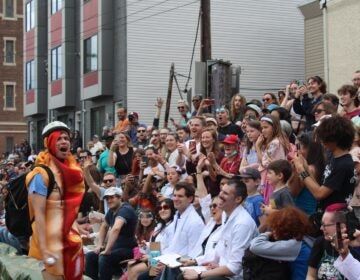Noble profession: As folk art, neon creations glow at Philly exhibit
For years, neon signs have been associated with cheap beer and cheap motels. They were Nick Mancuso’s bread and butter.
Mancuso’s rowhome in Northeast Philadelphia is filled with a lifetime of neon. A signmaker since the 1940s and now retired, he spent decades bending glass tubes for beer signage. In his spare time, he would occassionally make neon gifts for his grandchildren.
He’s part of the increasingly rare tribe of signmakers who know how to bend glass tubes.
“Kids today, they’re scared of the mercury. That’s got mercury in it,” said Mancuso, pointing to the white Philadelphia Phillies neon baseball he made for his grandson. He then points to the ruby-red heart bearing the name Laura, his granddaughter. “That don’t.”
During the Christmas season, the Mancuso house glows with unique, handmade neon decorations. Some of those pieces were borrowed for “Neon Art: Folk, Found, Fine,” an exhibition of fine-art and folk-art neon now on view at the Philadelphia Center for Architecture.
A small hallway gallery behind the storefront bookstore is crammed with dozens of glowing pieces by both trained artists and hobbyists. Some of the pieces ironically play with commercial signs, others are pure electric abstraction.
Neon beginnings as commercial craft
The show was pulled together by Len Davidson, a neon restorer, collector, and author of “Vintage Neon.” It develops his belief that although neon graduated from commercial advertising to fine art in the last 20 years (the Philadelphia Museum of Art has Bruce Nauman’s neon work in it collection, and “Neons for Buttonwood” by Stephen Antonakos can be seen every night atop an apartment building in the Logan Square neighborhood), it has its roots in commercial craft.
“Instead of putting neon in a fine-art category, it’s really all based on folk art,” said Davidson. “It was developed by tube benders, mom and pop shops, people who never went to art school.”
The exhibition includes work by a legend among neon tinkerers, Bill Connery. The retired machinist works with homemade lab equipment in his garage in Glenolden, Pa., allowing him to blow delicate glass flowers, set them in wooden transformer boxes. They pulse with thin strands of ionized gas. He has never shown them in a public exhibition.
“I guess you’d classify it as a rare-gas discharge tube,” said Connery, a little nonplussed when asked to explain it. “You’ve got argon, xenon, krypton, and helium. That’s all your rare gasses.”
Those gasses, also known as noble or inert, can produce different colors and effects. A glass tube filled with tiny glass beads will make light crackle. A high voltage in large tube of xenon will create an electrical storm so strong it vibrates in your hand, humming a loud drone. Manipulating gas and electricity allows these artists to paint with pure light.
WHYY is your source for fact-based, in-depth journalism and information. As a nonprofit organization, we rely on financial support from readers like you. Please give today.













